Correctness in vehicle positioning
25. August, 2010, Autor článku: Hodoň Michal, Elektrotechnika, Informačné technológie, Študentské práce
Ročník 3, číslo 8  Pridať príspevok
Pridať príspevok
 Although can be the positioning of a vehicle realized through various navigation systems, prime role in this field on all over the world plays methods of localisation through the satellite systems. From all possible systems has found mainly GPS (Global Positioning System) widespread use in many high precision applications. Even though it’s free services are not so accurate, modern enhancements methods can improve localization of the target to for about 10m. In this paper is explored accuracy and statistical review of GPS receiver with chipset MediaTek MT3329 in context with starting of public services of EGNOS (European Geostationary Navigation Overlay Service) system.
Although can be the positioning of a vehicle realized through various navigation systems, prime role in this field on all over the world plays methods of localisation through the satellite systems. From all possible systems has found mainly GPS (Global Positioning System) widespread use in many high precision applications. Even though it’s free services are not so accurate, modern enhancements methods can improve localization of the target to for about 10m. In this paper is explored accuracy and statistical review of GPS receiver with chipset MediaTek MT3329 in context with starting of public services of EGNOS (European Geostationary Navigation Overlay Service) system.
1 Introduction
With starting of EGNOS in 1.10.2009 should become positioning and localization itself more precise. EGNOS represents the system, which assigns improvement of the localization accuracy of navigation systems for all the Europe. It is projected as a supplement for the GPS, GLONASS and Galileo positioning systems. It consists of the transponders system, placed on the three geostationary satellites; from the network of circa 40 ground stations (Ranging and Integrity Monitoring Stations – RIMS); from the four master control centers (Gatwick (Great Britain), Langen (Germany), Torrejon (Spain) and Fucino (Italy)) and from the six up-link stations. (Fig. 1)
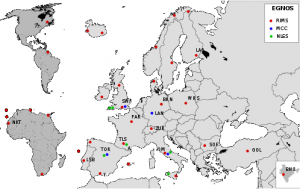
Fig. 1 Map of the EGNOS ground network
The EGNOS ground stations receive signals sent out by the satellites of the US localization system GPS NAVSTAR or the Russian GLONASS. Information about accuracy and reliability of these signals is transmitted to users through the geostationary satellite transponders. This allows them to determine their position to within two meters, compared with about 20 meters for GPS alone. Similar service is provided in North America by the Wide Area Augmentation System (WAAS), in Japan, by the Multi-functional Satellite Augmentation System (MSAS) and GPS Aided Geo Augmented Navigation (GAGAN) in India. (ESA, 2009)
The Open Service of EGNOS is provided free of charge. It means that all chips with EGNOS support should have after enabling this service better localization accuracy. This can be shown on measure differences made on known reference points of geodetic control, where is the location accuracy presented by the size of position deviation from given reference point.
2 Measure enviroment
For exploring of the GPS accuracy with coherence of the open EGNOS Service was chosen chip MediaTek MT3329 implemented in Holux M-1000C GPS receiver. MT3329 integrates, for achieving the best GPS receiving performance, a CMOS RF down-conversion circuitry, a base-band signal processing engine and it can track up to 66 satellites. It also provides a very good sensitivity on a receiving satellite signal, up to -165dBm.
Embedded WAAS/EGNOS demodulator, which is by default disabled, allows using DGPS – SBAS mode without any additional hardware (Differential Global Positioning System – Satellite Based Augmentation System). With orbit satellites it communicates through C/A code (Coarse/Acquisition code) on a single frequency (L1 = 1575.42MHz) and with control devices through the protocol NMEA0183 (V3.01). (Tab. 1) (Fig. 2)
Tab. 1 NMEA sentences
| GPGGA | Time, position and fix type data. |
|---|---|
| GPGSA | GPS receiver operating mode, DOP (dilution of precision) and active satellites. |
| GPGSV | Satellites in view. |
| GPRMC | The recommended minimum navigation information |
| GPVTG | Course and speed information relative to ground. |
| GLL | Geographic Position, Latitude / Longitude and time. |
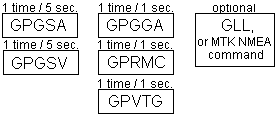
Fig. 2 Format of the NMEA0183 V3.01 protocol
3 Measure method
Measure method was based on an adequate amount of position measures made on the known static reference point, and on the differences between sizes of the errors acquired during the measurements with EGNOS support enabled and disabled. So the first step was to find out suitable reference point with the most accurate known coordinates.
As the best for this looked out the point from some system of geodetic points that’s location is determined geodetically. It means that its localization is made in connection with the keeping on the fixed technological principles in the specialized geodetic network, which results to the coordinates, altitude and gravimetric acceleration of the point, with accuracy that is characteristic for this network.
In Slovakia are reference points ordered in geodynamic network SGRN (Slovak Geodynamic Reference Network), where it is realized national terrestrial reference frame SKRF (Slovak Terrestrial Reference Frame) which is connected with the European terrestrial reference frame – EKRF, the most precise European Union recommended frame of reference for geo-data in Europe. The European Terrestrial Reference System 1989 (ETRS89) is an ECEF (Earth-Centered, Earth-Fixed) geodetic Cartesian reference frame, in which the Eurasian Plate as a whole is static.
The coordinates and maps in Europe based on the ETRS89 are not subjected to change due to the continental drift. (GKÚ, 2009) It is the only geodetic data to be used for mapping and surveying purposes in Europe, so it is ideal for testing the accuracy of GPS positioning. Therefore, considering previous, was as a reference point chosen geodetic point from this network, 2631ZA-1007, with following coordinates (JTSK is the coordinate system of uniform trigonometric cadastral network.):
- Latitude: B [ETRS89] 49° 12′ 22″ (X [JTSK] 1174160);
- Longitude: L [ETRS89] 18° 45′ 28″ (Y [JTSK] 442075);
These coordinates were further confronted with the results measured on this reference point by the GPS receiver, first with the SBAS mode disabled, next with the SBAS mode, and thereby the EGNOS support, enabled. The goal was to show how can satellite based augmentation system in Europe impact accuracy of GPS. However, the EGNOS signal by itself is transmitted through geostationary satellites. It means that its correct operations are conditioned by clear view on these satellites (in our case is it clear view on the south).
Position of chosen reference point met this requirement because it was located on the top of the hill, above the all housing developments, so there are no barriers that could block clear view on the sky. (Fig. 3) Another required condition (for correct working of DGPS system) is clear view on minimally 5 GPS satellites. If it is visible less than 5 GPS satellites, GPS receiver has not enough information for the high-accurate determining of its actual location. (Šimkovič, 2007)
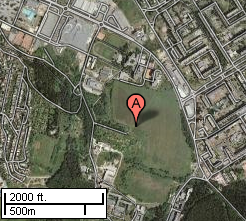
Fig. 3 Position of tested reference point
4 Measurement
Measurement was taken on 23rd of February 2010 in a time period from 09:00 AM to 12:00 AM. During this time it was stable weather, +7°C, half-cloudy (circa 25% cloud amount), atmospheric pressure 100kPa and no precipitation. (SHMÚ, 2010) GPS receiver was fixed on a reference point position, which was clearly determined due to the unequivocal geodetic sign. Then it started positioning in that way, that first 2 hours was the SBAS mode disabled and next 2 hours was the SBAS mode enabled.
And because the GPS receiver transmits position information every second in GPGGA (or GPRMC) message it was made ca. 14400 measurements (for each case 7200). For turning WAAS/EGNOS support on was used NMEA0183 input command for MTK chips: “$PMTK301,2*”. (Tab. 2)
Tab. 2 NMEA MTK input command “301” description
| $PMTK301, mode |
| 301 – PMTK_API_Set_Dgps_Mode (GPS correction data source mode) |
mode (DGPS data source mode):
|
Correctness of an executed task was confirmed by the response: “$PMTK001,301,3”. (Tab. 3)
Tab. 3 NMEA MTK output command “001” description
| $PMTK001, cmd, flag |
| 001 – PMTK_ACK (Acknowledge of PMTK command) |
| 0cmd – The command (packed) type acknowledge respond |
flag (DGPS data source mode):
|
5 Analysis of measured data
After measurement finishing and reading all measured data from the device log, it can be seen on the figures 4 and 5 impact of the EGNOS support on the accuracy of GPS positioning.
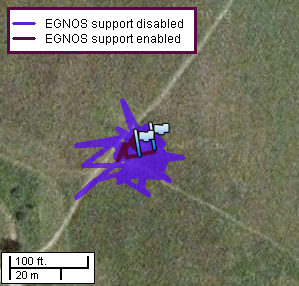
Fig. 4 Impact of the EGNOS support on the accuracy of GPS positioning
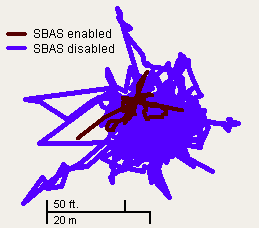
Fig. 5 Detailed view on the differences between positioning with and without EGNOS support (SBAS mode enabled)
From the pictures above is evident that, by applying of the EGNOS service, was increased accuracy of the positioning from about tens meters to only meters in peaks. This improvement could be shown on the differences between arithmetic means (1) and variances (2) counted from the single data acquired during separate measurements. (Tab. 4, Tab. 5)
| (1) |
| (2) |
Tab. 4 Expected values of coordinates confronted with reference coordinates calculated according to (1)
| Latitude | Longitude | |
|---|---|---|
| Reference point | 49° 12′ 22.000″ | 18° 45′ 28.0000″ |
| EGNOS disabled | 49° 12′ 22.1796″ | 18° 45′ 28.1484″ |
| EGNOS enabled | 49° 12′ 22.0896″ | 18° 45′ 28.0944″ |
From the table 4 is obvious that EGNOS service enabling can improve accuracy of positioning for about 50%. However, in real, this enhancement is not extremely high, because the positioning without EGNOS service had correctness ±10m. On the other hand, ±5 meters (reached with EGNOS support) can be good for applications, where is needed better accuracy than has the GPS standardly. In the table 5 is shown influence of the EGNOS service on the total variance of measured coordinates counted by (3).
| (3) |
Tab. 5 Improvement of the total variance influenced by EGNOS service
| Variance | |
|---|---|
| EGNOS disabled | 2.41476 E-08″ |
| EGNOS enabled | 0.10484 E-08″ |
| Improvement | 2.30992 E-08″ |
It follows that standard deviation (the square root of variance) was during EGNOS service enabled only ±0.03 E-03″ (±1m), what was caused by the low incidence of peak deviations during the measurement. Receiver in SBAS mode then processed clearer data and thereby is positioning more precise. Differences in measured positions (according to the reference point) were impacted by some one-way component, which could be influenced by many factors (weather, accuracy of GPS technology, accuracy of measurement…). On the figure 6 are presented final measured results according to the position of the reference point.
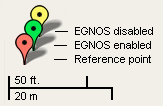
Fig. 6 Differences between measured positions according to the reference point
6 Conclusion
Although was the EGNOS designed as a supplement for Galileo system, it can be used also as a substitution of WAAS for GPS in Europe. Because it is free of charge and has quite good support from producers (embedded WAAS/EGNOS demodulators), it’s using in applications, where putting emphasis on accuracy plays significant role, has no barriers. However, during positioning with EGNOS support we must consider that reading information from EGNOS satellite takes obviously several minutes, data has no long lifetime period and the battery usage is higher.
Also nowadays GPS receivers have very good specifying algorithms that, also without EGNOS support, provide very good position determining (notably in vehicle navigation – movement on ways that can be predicted). In spite of this, using of EGNOS service provides considerable improvement of correctness in positioning alone.
References
- ESA (European Space Agency) – EGNOS ‘Open Service’ available: a new era for European navigation begins today. (2009)
http://www.esa.int/esaNA/SEM2HGF280G_egnos_0.html - GKÚ (Geodetický a kartografický ústav) – Geodetické základy. (2009)
http://www.gku.sk/predmet-cinnosti/geodeticke-zaklady - SHMÚ (Slovenský hydrometeorologický ústav) (2010)
http://www.shmu.sk/ - Šimkovič, J. – Presnosť prenosných GPS prístrojov. Lesnická práce (2007).
http://lesprace.silvarium.cz/content/view/2251/
University of Žilina, Faculty of Management Science and Informatics, Department of Technical Cybernetics, Univerzitná 1, 010 26 Žilina

